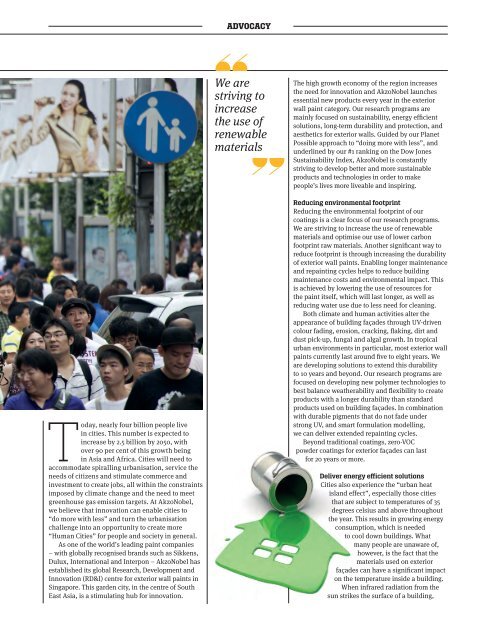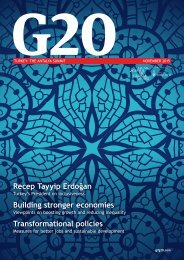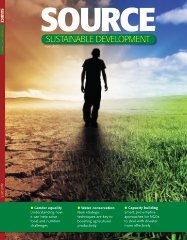G20 china_web
You also want an ePaper? Increase the reach of your titles
YUMPU automatically turns print PDFs into web optimized ePapers that Google loves.
ADVOCACY<br />
We are<br />
striving to<br />
increase<br />
the use of<br />
renewable<br />
materials<br />
The high growth economy of the region increases<br />
the need for innovation and AkzoNobel launches<br />
essential new products every year in the exterior<br />
wall paint category. Our research programs are<br />
mainly focused on sustainability, energy efficient<br />
solutions, long-term durability and protection, and<br />
aesthetics for exterior walls. Guided by our Planet<br />
Possible approach to “doing more with less”, and<br />
underlined by our #1 ranking on the Dow Jones<br />
Sustainability Index, AkzoNobel is constantly<br />
striving to develop better and more sustainable<br />
products and technologies in order to make<br />
people’s lives more liveable and inspiring.<br />
Today, nearly four billion people live<br />
in cities. This number is expected to<br />
increase by 2.5 billion by 2050, with<br />
over 90 per cent of this growth being<br />
in Asia and Africa. Cities will need to<br />
accommodate spiralling urbanisation, service the<br />
needs of citizens and stimulate commerce and<br />
investment to create jobs, all within the constraints<br />
imposed by climate change and the need to meet<br />
greenhouse gas emission targets. At AkzoNobel,<br />
we believe that innovation can enable cities to<br />
“do more with less” and turn the urbanisation<br />
challenge into an opportunity to create more<br />
“Human Cities” for people and society in general.<br />
As one of the world’s leading paint companies<br />
– with globally recognised brands such as Sikkens,<br />
Dulux, International and Interpon – AkzoNobel has<br />
established its global Research, Development and<br />
Innovation (RD&I) centre for exterior wall paints in<br />
Singapore. This garden city, in the centre of South<br />
East Asia, is a stimulating hub for innovation.<br />
Reducing environmental footprint<br />
Reducing the environmental footprint of our<br />
coatings is a clear focus of our research programs.<br />
We are striving to increase the use of renewable<br />
materials and optimise our use of lower carbon<br />
footprint raw materials. Another significant way to<br />
reduce footprint is through increasing the durability<br />
of exterior wall paints. Enabling longer maintenance<br />
and repainting cycles helps to reduce building<br />
maintenance costs and environmental impact. This<br />
is achieved by lowering the use of resources for<br />
the paint itself, which will last longer, as well as<br />
reducing water use due to less need for cleaning.<br />
Both climate and human activities alter the<br />
appearance of building façades through UV-driven<br />
colour fading, erosion, cracking, flaking, dirt and<br />
dust pick-up, fungal and algal growth. In tropical<br />
urban environments in particular, most exterior wall<br />
paints currently last around five to eight years. We<br />
are developing solutions to extend this durability<br />
to 10 years and beyond. Our research programs are<br />
focused on developing new polymer technologies to<br />
best balance weatherability and flexibility to create<br />
products with a longer durability than standard<br />
products used on building façades. In combination<br />
with durable pigments that do not fade under<br />
strong UV, and smart formulation modelling,<br />
we can deliver extended repainting cycles.<br />
Beyond traditional coatings, zero-VOC<br />
powder coatings for exterior façades can last<br />
for 20 years or more.<br />
Deliver energy efficient solutions<br />
Cities also experience the “urban heat<br />
island effect”, especially those cities<br />
that are subject to temperatures of 35<br />
degrees celsius and above throughout<br />
the year. This results in growing energy<br />
consumption, which is needed<br />
to cool down buildings. What<br />
many people are unaware of,<br />
however, is the fact that the<br />
materials used on exterior<br />
façades can have a significant impact<br />
on the temperature inside a building.<br />
When infrared radiation from the<br />
sun strikes the surface of a building,
















